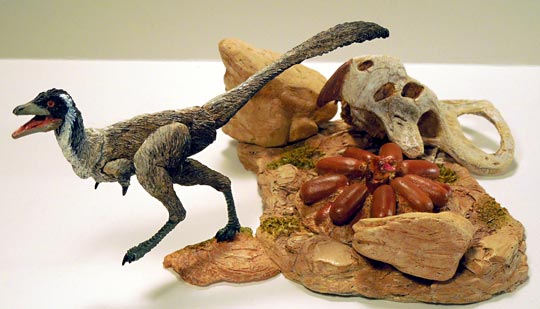“Chicken sized” Dinosaur Discovered In Alberta
Small Dinosaur – A possible Termite Eater from the Cretaceous (Alberta, Canada)
Details of the research undertaken to identify and describe a new type of North American dinosaur has just been published in the scientific journal “Cretaceous Research”. This dinosaur, at only 75 cm long and standing less than a metre tall is claimed to be the smallest dinosaur every discovered in North America.
This new species has been named Albertonykus borealis (northern clawed beast of Alberta), the fossils of this animal were discovered in the Red Deer formation of Alberta and it is believed to have been a fast running, insectivore with a similar lifestyle to the alvarezsaurids – dinosaurs such as Mononykus and Shuvuuia from Asia.
North American Dinosaur
The 70-million-year-old bones (Maastrichtian faunal stage), were found during an expedition to the Red Deer region to excavate the fossils of an Albertosaurus in 2002. The leader of that dig, Philip Currie removed the tiny fossil bones that had been found in association with the larger tyrannosaur and put them into storage at the Royal Tyrrell Museum in Drumheller. There the bones remained until University of Calgary palaeontologist Nick Longrich discovered them in one of the many storage draws and begun to work out just what sort of animal the bones represented.
A Model Set Featuring a Typical Member of the Alvarezsauridae
The Beasts of the Mesozoic Range
The picture (above) shows a replica of the alvarezsaurid dinosaur Mononykus from the: Beasts of the Mesozoic Model Range.
We know from experience that one of the best places to find a new species of dinosaur is not out in the field but in the storage areas of museums. For example, we once calculated that given the dinosaur material stored in plaster jackets at the Royal Tyrrell Museum, it would take our team hundreds of years to prepare them all.
In the journal article, the two authors describe the specimen and use the strong forelimbs, “s” shaped, flexible neck, agile long necks and pick-like claws as evidence to indicate a diet of insects such as termites and other burrowing creatures depicting a lifestyle similar to modern-day anteaters and pangolins.
The small dinosaur looks like a creature from a Dr Seuss book, said Longrich, who called the findings “pretty cool.”
“We’ve never seen one this far north. Before this we only had two bones from this type of animal ever seen in North America and now we’ve got almost a dozen bones, most of them from one site,” he added.
“So it doesn’t give us a perfect idea of what the animal looked like but it gives us a much better idea.”
This little dinosaur has been depicted in the illustration above using its shortened forelimbs to dig into tree stumps and fallen logs in search of insects such as termites. Albertonykus is depicted with a covering of downy feathers, this is in recognition of analysis of alvarezsaurid fossils from Mongolia that show traces of the chemical beta keratin which is found in feathers. A downy coat would help insulate this small, active animal and keep it warm.
Nick Longrich believes this discovery is important as it sheds light on the existence of smaller dinosaurs in the Red Deer River formation. It is very likely that small dinosaurs such as Albertonykus made up a large portion of the dinosaur fauna. However, it is the large bones of the bigger animals that have a greater preservation potential. Small delicate bones are less likely to be fossilised and indeed, many small carcases are eaten by predators.
This dinosaur is believed to a member of the Alvarezsauria, a group of small, bipedal dinosaurs with stunted forelimbs and reduced digits. The alvarezsaurid fossils from Mongolia have been dated to between 80 and 75 million years ago (Campanian faunal stage). The Alberta remains have been dated to approximately 70 million years ago. Although, it is not possible to build a relationship diagram based on these remains the presence of Albertonykus in younger strata may indicate that like the tyrannosaurs, the dinosaur ancestors of Albertonykus migrated into North America from Asia.
The dinosaurs found in Mongolia are estimated to be about 75 to 80 million years old, while the Alberta version is about 70 million years old.


